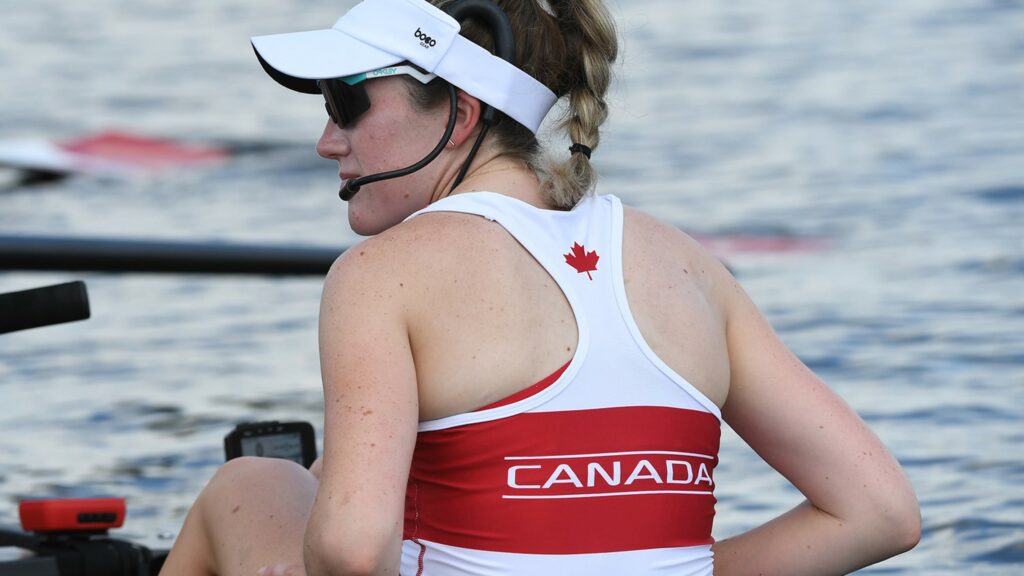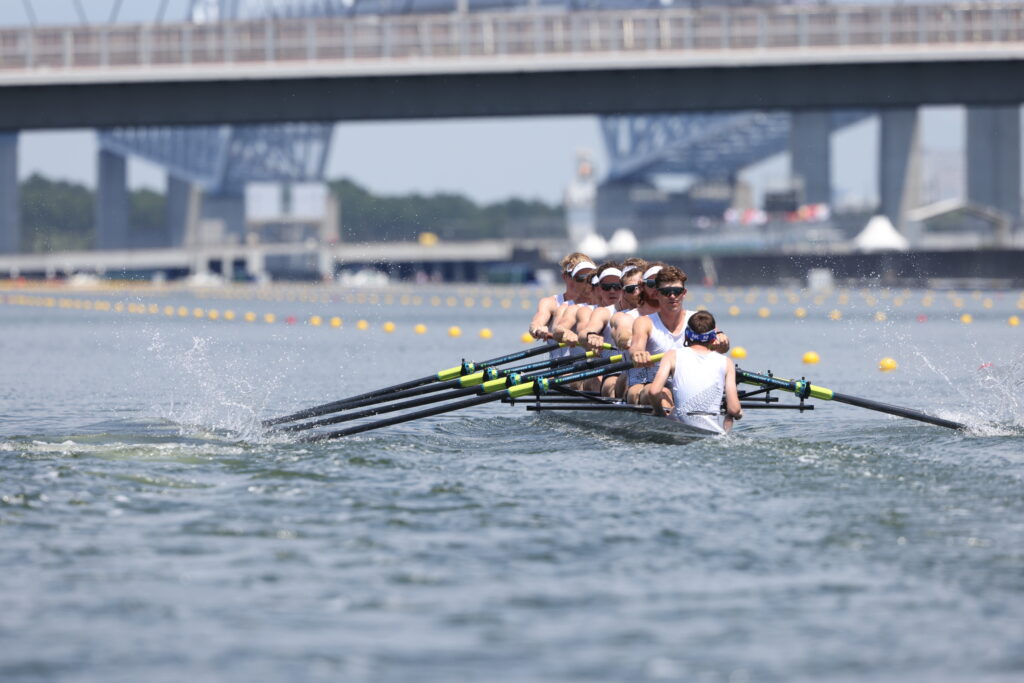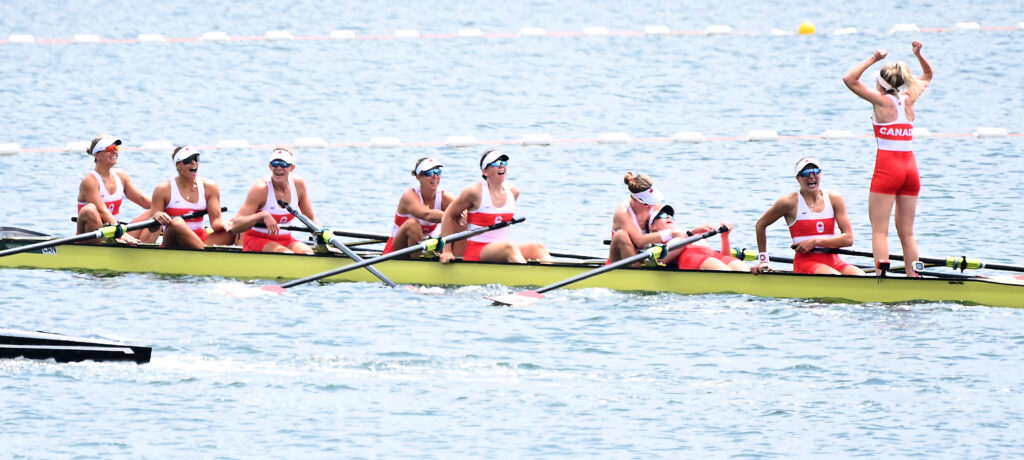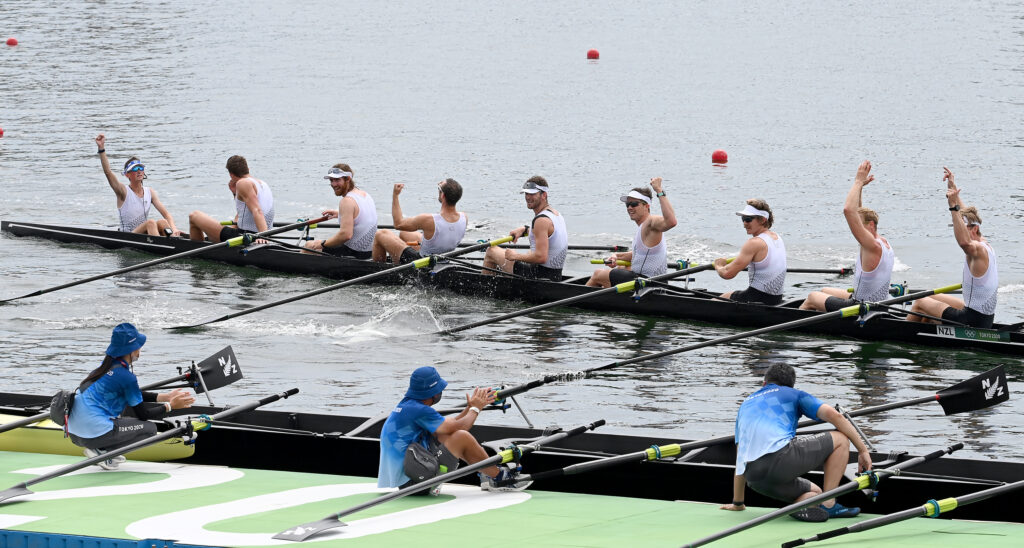
12 Nov 2021
In the head of a coxswain
The coxswain’s seat has always carried with it an air of mystery. It’s more difficult to quantify a coxswain’s contribution to the boat as compared to a rower. To shed light on this all-important role, World Rowing spoke with two of the world’s best coxswains: Sam Bosworth (NZL) and Kristen Kit (CAN). Bosworth and Kit both led their crews to, as some would argue, unexpected victories at the 2020 Olympic Games in Tokyo.
Pre-race prep
Leading up to the race, coxswains follow a different pre-race plan than their fellow athletes. Both Bosworth and Kit agree that it involves planning.
“I am a planner, most coxswains are,” Kit says. She runs through the notes that she has kept about the boat and the personality of the boat. “Keeping those themes fresh in my mind before a high stress race helps me keep the crew calm and focused on the task at hand.”
And Bosworth, who was trained at Christ College in New Zealand says that being on top of the planning helped him work his way up in a tough, eights-focused team.
“I normally am the one making the plan the night before (days before) in terms of timing. Wake up, meal timing, bus timetable, when to meet at the boat, erg workout, when are we getting boat down, etc,” Bosworth says.
Just before the racing, Bosworth takes the time to visualise. “I am just sitting there, thinking about the race plan and planning. We have a set race plan but having a think about extra calls I might put in, or a few different scenarios in my head,” he says.
Kit adds another element to her pre-race visualisation.
“I always try to do a hard workout while I visualise the calls. Doing something really hard, it gets me to that place. I’m in such a deep pain cave that I know the girls don’t need me to be a cheerleader, they need calm, they need precise, they need someone who is willing to be in battle with them,” she says.

Write it down
Both Bosworth and Kit are proponents of writing things down and keeping notes.
“I keep a really scrappy, ugly journal. I am looking through those journals for key words, key ideas. It’s not for particular calls, but it’s to make sure that I’m with the theme of the boat and the personality of the crew, what we’ve been thinking about technically,” she says.
Bosworth has a similarly ‘scrappy’ way of jotting things down.
“I definitely do write things down,” he says. “I think that’s very powerful. Even if you write it down and don’t read it again. I always carry a notebook, or bits of paper. For the Olympics I just had an A4 paper that I scribbled on throughout the week.”
To script, or not to script?
But when it comes to the racing, how much is actually scripted? How much do the coxswains follow an exact plan? That differs slightly between the two of them. For Kit, very little is scripted ahead of time.
“I visualise a lot, but I don’t plan,” she says. “We’ve got a race plan and it’s my responsibility to execute it. The women need to know what’s probably going to happen. In the Olympic final, I didn’t plan the calls I made, I just relied on our culture, the theme and the personality of the boat.”
While Bosworth has a slightly more scripted approach.
“All the technical things are scripted – we go out with a plan of what we’re going to work on for the race,” he says. With the crew at the Olympics, that meant pre-determined key words.
“Whenever I said some of those key words, everyone knew what we were doing, everyone was on the same page at the same time.”
Bosworth says he would never throw out anything different technically, but estimates that about 30% of his calls are made spontaneously in the race.
“In the Olympic final, calling out Bond going for his third Olympic medal, or calling out something that’s going to hype them up, they’ve never heard that before. It’s not that they need it, but it does bring an excitement to the crew,” he says.

The race plan
It’s not fully-scripted, but both coxswains do follow a pre-determined race plan, even if race plans in rowing are not always ground-breaking.
“I would venture to guess that most race plans are the same,” Kit says. “The unpredictability is the beauty of the sport and that lies in technique and the ability to hold form under pressure. You can’t write a race plan to make people do that.”
Kit says their race plan is informed by the boat feel.
“It’s my responsibility to make sure the rhythm feels good, it feels long, it feels sustainable. I can use metrics to inform that: rate, speed, wind, other boats. All these facts inform the race plan.”
Bosworth agrees that adaptability is key.
“We talk about it, we go out there and practice it,” Bosworth says. “But you do have to be adaptable, that’s the thing. You gain that from experience. You have a plan with the crew, but you’ve also got to be able to change it if it’s not going the way you want it to.”
Living the race
Once the plan is set, the athletes are ready and the crews have launched, it’s time to race. Do the coxswains actively live the race, are they conscious about it, or is it all a blur? This is where our two Olympic gold medallist coxswains diverge significantly.
For Kit, the race almost happens in slow motion. She is consciously experiencing every second of it.
“I almost feel like I have two sets of eyes, the in-boat eyes and the out-boat eyes. I am very aware of other boats, that was drilled into me from a young age, don’t miss any bowballs around you. The rowers, they trust you to be their eyes and ears, and you can’t lose that trust,” she says.
“I feel like my brain moves a mile a minute, but also very slowly. That’s something that has developed with the cycling races that I’ve done. In bike racing, it happens really fast, you’re going 50km an hour and into a sprint. But rowing racing, happens really slow. It’s 21-22km an hour and you only shift by about 0,5km an hour,” she explains.
“There’s a sense of energy change too. You can feel the energy change. There’s no fact based on that, but it’s a crucial point in the race, in the crew,” she says.
But Bosworth says that some of his best races are actually a blur. When he is really in the zone, not over-thinking things.
“In the Heat at the Olympics, I remember that I was actively thinking about steering. Whereas in the Final, I remember coming out of the blocks, but there’s definitely parts that are a blur. I was so internal in our boat, focused in our boat to the point the boys laughed. They said, ‘you didn’t actually tell us we were winning for a long time.’ It didn’t really phase me. I knew we were out in front, I knew what we were doing was going well.”
For Bosworth, he describes it differently, but reading the energy of the field also plays an important role in his coxing.
“The best you can do is to be proactive and not reactive. So, reading the field and knowing when we are starting to move, trying to get out and then we take charge of the race,” he says.

The Olympic final
Both Kit and Bosworth found themselves in the Olympic final. Both crews had taken the hard route – they had gone through the heat and then the repechage. Both crews say that going through the repechage was an advantage and may have led to their victory – it gave them one extra race to prepare for the final.
The Canadian team focused on their team culture. They built a mission and vision in the year leading up to the Olympics and stuck to it. For the final, they focused on two things.
“Staying present and it was never enough – that was our theme for our final,” says Kit. “We’d been rowed through in the heat and the repechage in the last quarter, so that’s what we focused on.”
Of course, it doesn’t always go to plan.
“I didn’t expect to be that far ahead of the start, going off at 48 spm,” Kit laughs. “There was a split second when I thought – did we go too hard? But the belief was so strong that no one was going to pass us on that day. I trusted my instinct and changed the race plan a little. I really lived that race with the women, I was so in the moment in that race.”
The Kiwi crew had a similar approach. Throughout the lead-up they worked on team culture and built a solid foundation of trust. The finals day, Bosworth says everything went well.
“It was just calm, we did our warm-up, everything felt relaxed,” he says. “We were on the Olympic startline, and I thought, let’s just go enjoy this. We had a lot of enthusiasm in the crew, and it wasn’t fake,” Bosworth says.
“We talked a lot about not needing the gold medal, a lot about wanting it. That really stuck with the crew,” he says.
Bosworth stuck to his plan, coxed the crew into the right rhythm and went from there. He was internally focused, and everything went right.

Coxing tips
Bosworth and Kit are arguably the two best coxswains in the world, so what do they recommend for the next generation?
Kit says to keep asking yourself: why not you?
“There were a lot of reasons for me why I shouldn’t have been in that boat, why I shouldn’t have made the national team. You have to believe in your core, why not you? There’s a lot of failure, that doesn’t always need to be career ending, think about what you can learn from it and how can you adapt it to be part of your story,” she says.
And Bosworth advises taking in as much as you can.
“Be like a sponge, that’s what I tell a lot of coxswains that I coach,” he says. “And don’t be afraid to ask for feedback, and then make the changes.”

